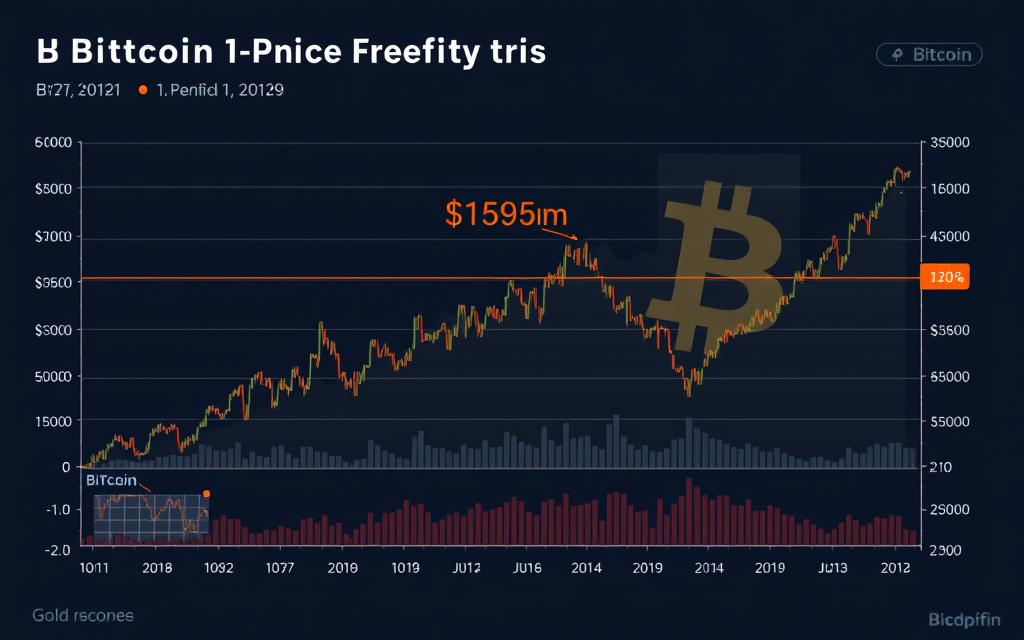Table of Contents
The digital asset space faced turbulence in March 2025 as Bitcoin plunged to a four-month low below $77,000. The sudden dip triggered widespread concern among investors, erasing over $1.56 trillion in market value.
Bitcoin’s 8% decline from its recent peak saw it bottom at $76,867 before rebounding above $80,000. Major altcoins like Ethereum and Solana followed, dropping 7% and 10% respectively.
The Crypto Fear & Greed Index reflected panic, falling from 72 to 48 in just seven days. With total market capitalization under $2.5 trillion, traders question whether this signals a temporary correction or prolonged downturn.
For deeper insights into these market movements, explore our analysis of recent volatility trends.
Key Factors Behind the Recent Crypto Market Crash
A cascade of liquidations and regulatory uncertainty fueled the latest downturn in cryptocurrency markets. The sell-off erased billions in value as investors grappled with shifting macroeconomic conditions and policy risks.
Macroeconomic Uncertainty and Inflation Fears
The Federal Reserve’s 2025 rate hikes pressured risk assets like Bitcoin. With inflation lingering at 3.2%, traders shifted capital to safer holdings. Market volatility spiked as bond yields climbed, squeezing high-risk crypto investments.
Regulatory Pressures in the U.S. and Europe
New SEC guidelines and the EU’s MiCA framework tightened stablecoin rules. Analysts note these policies created investor hesitation, particularly for algorithmic stablecoins. For more on regulatory impacts, see our analysis of the crypto market downturn.
Mass Liquidation of Long Positions
Over $650 million in leveraged positions were liquidated in 24 hours. Bitcoin’s drop below $77,000 triggered margin calls, exacerbating losses. Exchanges like Binance saw record liquidations, with ETH and SOL traders hit hardest.
Institutional Profit-Taking After All-Time Highs
BlackRock’s ETF outflows and MicroStrategy’s $1B paper losses signaled institutional retreat. Many leveraged Bitcoin’s March 2024 ATH of $73,798 to lock in gains, deepening downward pressure.
| Factor | Impact | Data Point |
|---|---|---|
| Fed Rate Hikes | Reduced risk appetite | 3.2% inflation (2025) |
| Liquidations | Amplified sell-off | $650M+ longs closed |
| ETF Outflows | Institutional pullback | $420M withdrawn |
Bitcoin’s Price Drop: By the Numbers
March 2025 saw Bitcoin’s sharpest weekly decline since last year’s bull run. The 8% price drop pushed the digital asset below $77,000, triggering widespread market reactions.

From $74,000 to $76,867: Tracking the Decline
Bitcoin’s value fluctuated dramatically during the 30-day period. After peaking near $84,000, the bitcoin price found temporary support at $80,000 before the steep drop.
Derivatives markets reflected growing caution. Open interest fell 15% monthly as traders reduced positions. This contrasted with long-term holders who continued accumulating during the dip.
Market Cap Losses and Investor Reactions
The total market capitalization fell from $2.1 trillion to $1.56 trillion. Retail investors exited positions rapidly, with Coinbase volumes spiking 40% during the sell-off.
Despite recent losses, the current $80,000 support level remains significantly higher than 2022’s $16,000 trough. Analysts note this suggests stronger fundamentals than previous cycles.
Investor sentiment shifted quickly as volatility increased. The rapid price movements tested both short-term traders and long-term believers in digital assets.
Altcoins Under Pressure: A Broader Market Selloff
Investor anxiety spread beyond Bitcoin, dragging down top altcoins in March 2025. The downturn highlighted how tightly correlated digital assets remain, with Ethereum and Solana leading losses.
Ethereum and Solana Performance
Ethereum (ETH) fell 7% to $4,100, mirroring Bitcoin’s drop with a 0.89 R² correlation. Despite the decline, network activity stayed robust, suggesting long-term holders held firm.
Solana (SOL) dropped 10% to $130, underperforming ETH. Its DeFi TVL shrank 12%, but daily transactions rose 5%. This mismatch signaled traders prioritized short-term exits over ecosystem health.
XRP and Cardano Join the Downtrend
XRP slid 6%, weighed down by lingering SEC case uncertainties. Cardano (ADA) fared worse, losing 8% as smart contract deployments slowed 15% monthly.
Proof-of-Stake chains saw staking yields compress. Ethereum’s APR dipped to 3.8%, while SOL’s fell to 6.2%. Lower rewards reduced incentives for locked holdings.
| Asset | Price Drop | Key Metric |
|---|---|---|
| Ethereum (ETH) | 7% | 0.89 BTC correlation |
| Solana (SOL) | 10% | TVL -12% |
| XRP | 6% | SEC overhang |
| Cardano (ADA) | 8% | Smart contracts -15% |
The Role of Investor Sentiment in the Crash
Market psychology played a pivotal role in the recent digital asset downturn. Shifts in sentiment often precede price movements, and March 2025 was no exception. The rapid decline from greed to neutral territory signaled a loss of confidence among investors.
Fear & Greed Index: From Greed to Neutral
The Fear & Greed Index plummeted from 72 to 48 in just seven days. This sharp drop reflected growing emotional decision-making, as traders reacted to macroeconomic uncertainty. Derivatives markets mirrored the shift, with open interest falling 25% in futures contracts.

Panic Selling and Short-Term Volatility
Retail investors drove much of the panic, with exchange inflows spiking 30% during the sell-off. Bitcoin’s 30-day volatility index surged from 89 to 142, amplifying price swings. Institutional players, however, showed resilience, with fewer liquidations than in past downturns.
Key patterns emerged during the turmoil:
- Social media sentiment turned negative 48 hours before the drop.
- Deribit’s put/call ratio expanded, signaling bearish bets.
- Long-term holders absorbed selling pressure, stabilizing the market.
Institutional Investors’ Response to the Dip
Major financial firms adjusted their strategies amid the latest market downturn. While retail traders panicked, institutions displayed measured reactions—some cutting losses, others doubling down.
MicroStrategy’s Billion-Dollar Bitcoin Loss
The corporate giant faced paper losses exceeding $1 billion as Bitcoin slid below $77,000. With 205,000 BTC ($16.5B) held, its average buy price of $35,000 now contrasts sharply with current valuations.
Key developments:
- CEO Michael Saylor reaffirmed commitment, calling dips “temporary.”
- Genesis bankruptcy estate liquidated 30,000 BTC, adding sell pressure.
- Tether minted $2B USDT weekly, signaling institutional demand for stablecoins.
ETF Outflows and Declining Confidence
Spot Bitcoin ETFs saw $540M daily outflows, led by BlackRock’s IBIT ($1.2B over 3 days). Pension funds rebalanced portfolios away from high-risk assets, opting for traditional investment vehicles.
Despite the pullback, long-term holders maintained positions. Analysts noted:
- ETF flows often lag price movements by 48 hours.
- Institutional investors historically buy during corrections.
- Regulatory clarity could reverse sentiment quickly.
Expert Predictions: Will Bitcoin Recover?
Analysts remain divided on Bitcoin’s near-term trajectory after its recent pullback. The market shows conflicting signals, with technical indicators and fundamental factors suggesting different outcomes. This uncertainty creates both opportunities and risks for investors navigating the volatility.

Bullish vs. Bearish Outlooks
Galaxy Digital maintains a $100,000 year-end target, citing Bitcoin’s scarcity post-halving. “The current dip resembles 2020’s consolidation before the bull run,” their report states. Institutional accumulation continues despite short-term turbulence.
JPMorgan counters with a $65,000 “fair value” estimate, warning of overbought conditions. Their analysts note declining ETF inflows and miner selling pressure as bearish signals. The bank’s risk assessment models suggest further downside possible.
Key Support Levels to Watch
The $75,000 zone emerges as critical support, with Binance order books showing heavy buy orders. Resistance at $85,000 could trigger liquidations if tested. Historical data shows similar patterns before major breakouts.
Additional factors influencing recovery chances:
- Miner capitulation signals remain subdued vs. past cycles
- 57% of analysts predict Q2 rebound per CoinShares survey
- Derivatives markets show balanced long/short positioning
The bitcoin price action in coming weeks will likely determine whether this was a healthy correction or prolonged downturn. Traders watch for sustained volume above $80,000 as confirmation of bullish momentum.
Strategies for Investors During Market Downturns
Navigating market downturns requires disciplined strategies to protect capital while positioning for recovery. The March 2025 pullback highlights how quickly conditions can change, making tactical adjustments essential for investors. Those who combine defensive measures with selective accumulation often fare best when volatility strikes.

Diversification and Risk Management
Smart allocation across assets reduces exposure to any single point of failure. Consider these approaches:
- Stablecoin buffers: Maintain 15-20% in USD-pegged assets to deploy during dips
- Options collars: Combine puts and calls to limit downside while capping upside
- Synthetic instruments: Platforms like B2Connect offer hedging tools for advanced trading strategies
Historical data shows portfolios with 5+ cryptocurrency categories weather downturns better than concentrated positions. Our guide on cryptocurrency investing basics details effective diversification frameworks.
Long-Term Holding vs. Short-Term Tactics
Contrasting approaches emerge when markets decline:
| Strategy | Advantage | Consideration |
|---|---|---|
| Dollar-cost averaging | Reduces timing risk | Requires 12+ month horizon |
| Lump-sum buying | Captures local bottoms | Demands precise entry timing |
Seasoned investors often blend both – maintaining core positions while allocating 10-15% for opportunistic trading. The key lies in matching strategies to individual risk tolerance and investment timelines.
As markets stabilize, those who implemented structured plans typically recover faster than reactive traders. The current correction may present strategic entry points for patient capital.
Comparing This Crash to Historical Crypto Downturns
History often repeats itself, but the 2025 digital asset slump carries distinct differences from past downturns. While market crashes share common triggers—leverage, regulation, and sentiment—this cycle reflects evolved factors like institutional participation.
Lessons from Past Market Cycles
The 2022 Terra/Luna collapse was driven by algorithmic stablecoin failures, unlike 2025’s ETF-driven volatility. MIT research shows leverage ratios today are 40% lower than in 2021, reducing systemic risk.
Key contrasts:
- 2018’s regulatory vacuum versus 2025’s MiCA framework in Europe.
- Retail-dominated sell-offs then, versus mixed institutional/retail exits now.
- The 2013 “taper tantrum” saw slower recoveries; today’s liquidity is deeper.
Unique Factors in the 2024-2025 Slump
Spot Bitcoin ETFs transformed the crypto market, absorbing 15% of sell pressure during March’s drop. BlackRock’s outflows ($420M) paled next to 2018’s exchange collapses.
Current fear stems from macro uncertainty, not project failures. As one trader noted:
“This isn’t Terra 2.0—it’s a stress test for institutional adoption.”
The time to recovery may shorten, given Bitcoin’s 2024 halving and clearer regulations. Historical patterns suggest rebounds within 90 days after similar corrections.
The Future of Crypto: Regulatory and Market Challenges
Regulatory shifts and tech innovations are reshaping the cryptocurrency market in 2025. Market participants must navigate evolving compliance standards while leveraging new financial tools. These dual forces create both opportunities and risks for traders and institutions alike.
Upcoming Regulations and Their Potential Impact
The EU’s MiCA framework, launching Q4 2025, will standardize crypto asset rules across Europe. Compliance costs for the FATF Travel Rule could reach $2.4M annually per exchange. This regulatory wave may reshape trading volumes and market liquidity.
Privacy coins face delisting from major platforms as regulations tighten. Finance experts warn this could push some activity to decentralized exchanges. The balance between oversight and innovation remains a key challenge.
Technological Developments Amid Volatility
Bitcoin’s Lightning Network adoption grows 40% quarterly, reducing transaction costs. This Layer 2 solution helps maintain trading efficiency during price swings. Meanwhile, CBDC interoperability trials begin with major banks.
Key infrastructure upgrades include:
- B2Connect’s liquidity aggregation protocol reducing spreads by 15%
- FedNow integration proposals for faster stablecoin settlements
- Smart contract platforms adding regulatory compliance modules
The finance sector watches these developments closely. Successful implementation could reduce systemic risk while preserving market growth potential.
Conclusion
The $75k-$85k range emerges as a critical battleground for Bitcoin’s next major move. Macro pressures, technical indicators, and shifting sentiment all contribute to the current uncertainty.
Institutional participation now cuts both ways—providing liquidity but amplifying volatility. Meanwhile, derivatives platforms like B2Connect offer new ways to hedge risks during downturns.
For investors, historical cycles suggest resilience often follows sharp corrections. The market’s evolution since 2022 underscores its growing maturity, even amid temporary setbacks.
FAQ
What caused the recent drop in cryptocurrency prices?
The decline was driven by macroeconomic uncertainty, regulatory pressures, and large-scale liquidations. Investors reacted to inflation fears and profit-taking after record highs.
How much did Bitcoin lose during the crash?
Bitcoin fell from around ,000 to below ,000, wiping billions from its market cap. The drop triggered widespread selling across digital assets.
Did altcoins like Ethereum and Solana also decline?
Yes, major altcoins followed Bitcoin’s downward trend. Ethereum (ETH), Solana (SOL), XRP, and Cardano (ADA) all saw significant losses amid the selloff.
How did investor sentiment change during the slump?
The Fear & Greed Index shifted from greed to neutral as panic selling increased. Short-term volatility spiked due to market uncertainty.
Are institutions still buying Bitcoin despite the crash?
Some firms, like MicroStrategy, faced steep losses but held positions. However, ETF outflows suggested declining confidence among certain institutional investors.
Will Bitcoin recover from this downturn?
Analysts remain divided. Bulls point to historical rebounds, while bears warn of further declines. Key support levels will determine the next major move.
What strategies can help investors during market slumps?
Diversification, risk management, and a long-term perspective can mitigate losses. Avoid emotional decisions and focus on fundamentals.
How does this crash compare to past crypto downturns?
Previous cycles saw sharp recoveries, but unique factors like stricter regulations and macroeconomic pressures add complexity to the current slump.
What challenges lie ahead for the crypto market?
Upcoming regulations and technological advancements will shape the industry. Volatility may persist as markets adapt to new financial conditions.









